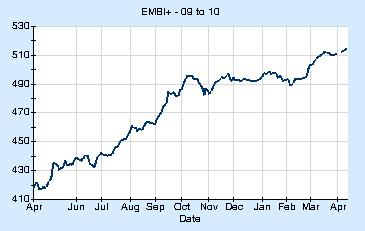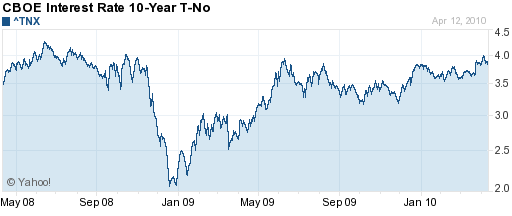April 14th 2010
Forex Market Inverts as Emerging Markets Soar
As I pointed out in last Friday’s post (Volatility, Carry, Risk, and the Forex Markets), volatility has been declining in forex markets since peaking after the collapse of Lehman Brothers. In fact, volatility among emerging market currencies has been falling particularly fast, and recently, something amazing happened: “Three-month implied volatility for the seven biggest developing country currencies fell to 10 percent in March compared with 11.4 percent for industrialized nations.” This inversion could rank as one of this year’s most important developments in terms of its impact on forex. The only runner-up that I can think of is Japanese LIBOR falling below American LIBOR.
Despite its remarkableness, this development isn’t unsurprising, since 8 of the 10 best performers in forex this year are emerging market currencies, led by the Costa Rican Colon, Mexican Peso, and Malaysian Ringgit. Still, we usually assume that with high return, comes high risk. How could it be that what are thought of as risky currencies are now less volatile than the so-called majors. Does it really make sense, for example, that the Turkish Lira is less volatile than the British Pound.
Without exploring this particular pair in detail, in a word, the answer is yes. In 2010, emerging market growth is projected to be higher than in the industrialized world. Inflation is relatively stable, and debt levels are comparatively low. Meanwhile, all of the G4 currencies (US Dollar, Euro, Japanese Yen, and British Pound) are plagued by the possibility of Double-Dip recessions and debt crises of varying seriousness. In sum, “Developing nations reduced their foreign debt to 26 percent of GDP last year from 41 percent in 1999, while advanced nations’ debt may surge to 106.7 percent of GDP this year from 78.2 percent in 2007.” Talk about heading in opposite directions!

Investors are taking notice. While the JP Morgan Emerging Market Bond Index (EMBI+) is now rising at annualized rate of 22% (implying a decline in emerging market bond yields), rates on comparable EU and US debt is rising. Last week, the 10-Year Treasury Rate topped 4% for the first time in 18 months (though it has since retreated). Meanwhile, credit default swaps are pricing in a .4% chance of default in the US. Granted, this is still infinitesimal, but anything above 0% would have been derided as ridiculous only a few years ago. This year, the US is projected to spend more on servicing its debt than any other country except for the UK. The projected $1.6 Trillion deficit for 2010 certainly won’t help things.

Thus, emerging markets are projected “to lure $722 billion in overseas investment this year, 66 percent more than in 2009…Developing-nation bond funds attracted $7 billion this year, pushing assets under management to a record $74.7 billion.” Many portfolio managers are betting that this will be a long-term trend: “The rally in emerging-markets has barely started yet.”
What are the forex implications? For the first time, we could see the G4 currencies start trading as a bloc. [Previously, it was the US Dollar versus everything else. The introduction of the Euro ten years ago only strengthened this trend, which is ironic considering the EU has also become an establishment currency. But, if you look at the charts, the Dollar/Euro pair has rarely traded sideways, and traders have used it as a basis for making broader claims about the markets]. Now, it looks like this could finally change: “The big trends will be in non-G4 currencies against G4, such as dollar/Norway or euro/Aussie, and in emerging market currencies.”




April 16th, 2010 at 4:01 pm
[…] Adam Kritzer discusses the changes in forex trading – how it inverts as emerging markets soar. […]